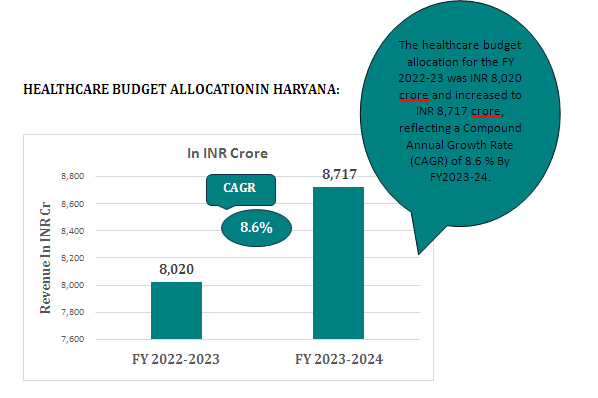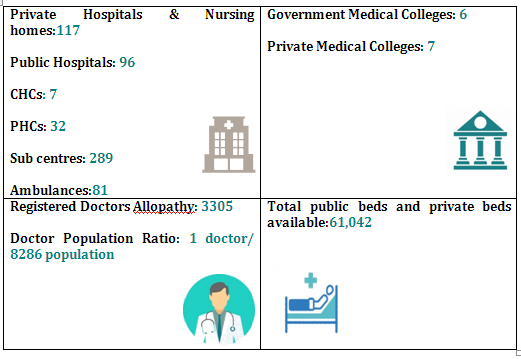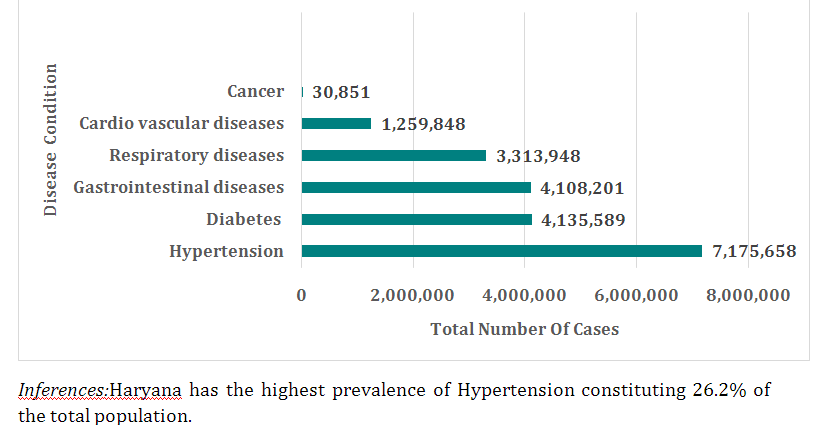Are you currently looking into venturing or investing into the healthcare sector in Haryana? Are you looking for concrete details on the current status of the Healthcare scenario in Haryana? In this article, Hospaccx Healthcare Consultancy brings to you the latest bits of Information on Haryana current Healthcare Systems.
INTRODUCTION:
Haryana, a state located in northern India, is known for its rich cultural heritage, agricultural productivity, and rapid industrial growth. The state places significant emphasis on the healthcare sector and strives to provide accessible and quality medical services to its residents. The healthcare infrastructure in Haryana is well-developed, with a network of hospitals, clinics, and healthcare centres spread across the state. The Department of Health and Family Welfare, Haryana, is responsible for planning, implementing, and monitoring various healthcare initiatives to ensure the well-being of its population. This blog aims to provide an introduction to the healthcare scenario in Haryana, highlighting key features, initiatives, and challenges within the state’s healthcare system.
DEMOGRAPHIC PROFILE



HEALTH INDICATORS

DISEASE BURDEN IN HARYANA:

HEALTHCARE INITIATIVES BY HARYANA GOVERNMENT
| Name of Scheme | Features & Benefits |
| Mukhya Mantri Muft Ilaaj Yojana (MMMIY): | · Launched Year :2013
· Beneficiaries: Under this scheme, families living below the poverty line are provided with free healthcare services at government hospitals and empanelled private hospitals. · The scheme covers essential healthcare services, including diagnostics, hospitalization, surgeries, and medicines. |
| Laadli Laxmi Yojana: | · Launched Year: 2005
· Beneficiaries: Pregnant woman and infants from economically disadvantaged families. This scheme focuses on improving maternal and child health. It provides financial assistance to pregnant women and offers support for nutrition, antenatal care, institutional delivery, and postnatal care. · The scheme aims to reduce maternal and infant mortality rates and improve the overall well-being of women and children. |
| Free Dialysis Scheme: | · Launched Year: 2016
· Beneficiaries: Haryana has implemented a Free Dialysis Scheme to provide free dialysis services to eligible patients suffering from kidney ailments. This scheme ensures that patients have access to life-saving dialysis treatment without financial burden.
|
LIST OF MAJOR HOSPITALS IN HARYANA:
Government Hospitals
- Post Graduate Institute of Medical Sciences (PGIMS), Rohtak: Established in 1960, is a renowned government hospital with over 2,100 beds, spread over 350 acres making it a significant healthcare institution in the region.
- BPS Government Medical College for Women, Khanpur Kalan: Established in 2012, is a prominent government hospital with a capacity of over 500 beds, the institute is spread over 88 acres in which specializing in women’s healthcare services.
- Kalpana Chawla Government Medical College, Karnal: Founded in 2017, operates a hospital with 300 beds which will be increased to 700 in a phased manner, the college is spread over 50 acres providing medical education and specialized healthcare services.
- Civil Hospital, Gurugram: The hospital was built in 1697 and recognized for its extensive infrastructure and more than 200 beds, it is spread over 7 acres, plays a vital role in meeting the healthcare requirements of the city’s population.
- Civil Hospital, Ambala: Which has been serving the community for several years, provides medical services with its extensive facility of over 200 beds.
Private Hospitals
- Medanta – The Medicity, located in Sector 38, Gurgaon: Established in 2009, is a renowned hospital with over 1,250beds, spread over 43 acres.
- Artemis Hospital, situated in Sector 51, Gurgaon:Established in 2007, is hospital with over 600 beds, spread over 9 acres.
- Fortis Memorial Research Institute (FMRI),located in Sector 44, Gurgaon: Established in 2001, is a renowned hospital with over 299 beds, spread over 1,50,000 sq. feet.
- Park Hospital,Established in 1982, is a renowned government hospital with a bed capacity of 250beds.
- Columbia Asia Hospital in Palam Vihar, Established in 2008, the hospital has a bed capacity of 90 beds.
Medical Colleges
- Post Graduate Institute of Medical Sciences (PGIMS), Rohtak: Established in 1960, is a renowned government hospital with over 2,100 beds, spread over 350 acres making it a significant healthcare institution in the region. It has an intake of 200 seats.
- BPS Government Medical College for Women, Khanpur Kalan: Established in 2012, is a prominent government hospital with a capacity of over 500 beds, the institute is spread over 88 acres in which specializing in women’s healthcare services. It has an intake of 120 MBBS seats.
- Shaheed Hasan Khan Mewati Government Medical College, Nalhar, Mewat: Established in 2012, has over 500 beds and offers 120 MBBS seats. It is affiliated with Pt. B.D. Sharma University of Health Sciences. It is spread over 72 acres.
- Kalpana Chawla Government Medical College, Karnal: Founded in 2017, operates a hospital with 300 beds which will be increased to 700 in a phased manner, the college is spread over 50 acres providing medical education and specialized healthcare services. It has an intake of 100 MBBS seats.
- Maharaja Agrasen Medical College, Agroha: Established in 1988, has over 550 beds and offers undergraduate with 100 seats and postgraduate programs seats 22. It is affiliated with Pt. B.D. Sharma University of Health Sciences.
HEALTHCARE INVESTMENT OPPORTUNITIES IN HARYANA:
- Growing population:
- The population of Haryana for the year 2023 is 27,388,008 Crores and is estimated to project 3 Crores by the year 2030 with annual growth rate of 8.7%.
- Gap in medical infrastructure:
- In the state, the total number of available beds, including both government and private sectors, is 61,042 beds. According to the norms, there should be 5 beds per 1,000 population. Hence, there is a need for 1,35,000 beds, indicating a gap of 73,958 beds in the state’s healthcare infrastructure.
- Currently there are 572 diagnostic centres in Haryana. As per the norms there should be 1 diagnostic centre per 10,000 population. Therefore, there is a requirement of 2,350 diagnostic centre indicating a gap of 1,778 diagnostic centre in the state.
- Government assistance in healthcare investment:
ULTRA MEGA PROJECTS: The Haryana Enterprise Promotion Board will provide an individually tailored package of incentives to Ultra-Mega Projects across the State.
- MEGA PROJECTS (regular incentive package):
- a) Investment Subsidy in lieu of Net SGST:
- In case of Megaprojects with inverted duties may be eligible for an investment subsidy of up to 5% of FCI over an 8-year term in equal yearly payments, with a cap of INR 5 crore per megaproject per year.
- If Net SGST deposited under cash ledger falls below 5% of FCI in a given year, the Investment Subsidy up to 5% of FCI may be granted for a period of 8 years in equal yearly payments, subject to an annual cap of INR 5 crore per mega project.
b)Haryana Gramin Udyogik Vikas Yojana:
- Capital Subsidy: 15%, up to a total of Rs. 20 lakhs, and up to a total of Rs. 25 lakhs for Women/SC for Micro Enterprises on the investment made in Plant & Machinery and Building.
- Micro Enterprisesare eligible for an interest subsidy of 7% on term loans, up to a maximum of Rs. 8.00 lakh per year for a period of seven years.
- Micro businessesare eligible for a DG Set Subsidy of up to 50% of the cost of the DG Set, maximum INR 8000 per KVA.
CONCLUSION
In conclusion, the healthcare scenario in Haryana showcases the state’s commitment to providing accessible and quality medical services to its residents. The healthcare infrastructure, including government and private hospitals, medical colleges, and healthcare schemes, has been developed to cater to the healthcare needs of the population. However, Haryana also faces several challenges, such as infrastructure gaps, shortage of healthcare professionals, geographical disparities, and the burden of non-communicable diseases. Despite the progress, there is a need to continue addressing the challenges and further strengthen the healthcare system in Haryana. This includes infrastructure development, ensuring an adequate healthcare workforce, bridging the urban-rural healthcare divide, improving health information systems, and promoting preventive measures for non-communicable diseases. By prioritizing these areas and implementing evidence-based policies, Haryana can strive towards achieving a robust and inclusive healthcare system that meets the needs of its growing population.
Above is the superficial and macro level study for in-depth market and financial feasibility studies or any other healthcare-related research needs, please feel free to reach out to us at +91-8655170700 or email us at hospaccx.india@gmail.com. Our team is equipped to provide comprehensive and detailed insights tailored to your specific requirements.

